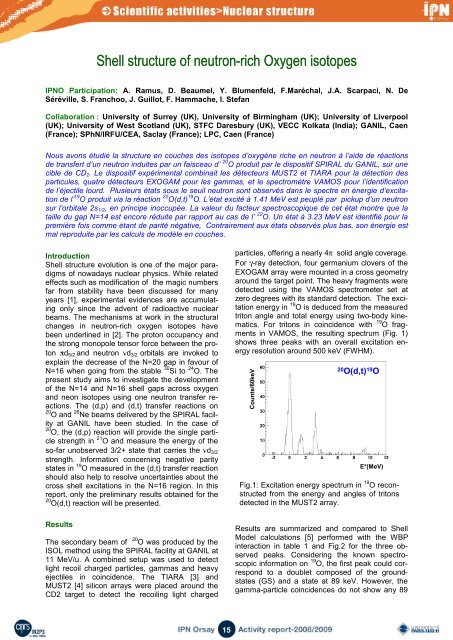exotic nuclei structure and reaction noyaux exotiques ... - IPN - IN2P3
exotic nuclei structure and reaction noyaux exotiques ... - IPN - IN2P3
exotic nuclei structure and reaction noyaux exotiques ... - IPN - IN2P3
Create successful ePaper yourself
Turn your PDF publications into a flip-book with our unique Google optimized e-Paper software.
Counts/60keV<br />
Shell <strong>structure</strong> of neutron-rich rich Oxygen isotopes<br />
<strong>IPN</strong>O Participation: A. Ramus, D. Beaumel, Y. Blumenfeld, F.Maréchal, J.A. Scarpaci, N. De<br />
Séréville, S. Franchoo, J. Guillot, F. Hammache, I. Stefan<br />
Collaboration : University of Surrey (UK), University of Birmingham (UK); University of Liverpool<br />
(UK); University of West Scotl<strong>and</strong> (UK), STFC Daresbury (UK), VECC Kolkata (India); GANIL, Caen<br />
(France); SPhN/IRFU/CEA, Saclay (France); LPC, Caen (France)<br />
Nous avons étudié la <strong>structure</strong> en couches des isotopes d’oxygène riche en neutron à l’aide de réactions<br />
de transfert d’un neutron induites par un faisceau d’ 20 O produit par le dispositif SPIRAL du GANIL, sur une<br />
cible de CD 2 . Le dispositif expérimental combinait les détecteurs MUST2 et TIARA pour la détection des<br />
particules, quatre détecteurs EXOGAM pour les gammas, et le spectromètre VAMOS pour l’identification<br />
de l’éjectile lourd. Plusieurs états sous le seuil neutron sont observés dans le spectre en énergie d’excitation<br />
de l’ 19 O produit via la réaction 20 O(d,t) 19 O. L’état excité à 1.41 MeV est peuplé par pickup d’un neutron<br />
sur l’orbitale 2s 1/2 , en principe inoccupée. La valeur du facteur spectroscopique de cet état montre que la<br />
taille du gap N=14 est encore réduite par rapport au cas de l’ 22 O. Un état à 3.23 MeV est identifié pour la<br />
première fois comme étant de parité négative, Contrairement aux états observés plus bas, son énergie est<br />
mal reproduite par les calculs de modèle en couches.<br />
Introduction<br />
Shell <strong>structure</strong> evolution is one of the major paradigms<br />
of nowadays nuclear physics. While related<br />
effects such as modification of the magic numbers<br />
far from stability have been discussed for many<br />
years [1], experimental evidences are accumulating<br />
only since the advent of radioactive nuclear<br />
beams. The mechanisms at work in the structural<br />
changes in neutron-rich oxygen isotopes have<br />
been underlined in [2]. The proton occupancy <strong>and</strong><br />
the strong monopole tensor force between the proton<br />
d 5/2 <strong>and</strong> neutron d 3/2 orbitals are invoked to<br />
explain the decrease of the N=20 gap in favour of<br />
N=16 when going from the stable 30 Si to 24 O. The<br />
present study aims to investigate the development<br />
of the N=14 <strong>and</strong> N=16 shell gaps across oxygen<br />
<strong>and</strong> neon isotopes using one neutron transfer <strong>reaction</strong>s.<br />
The (d,p) <strong>and</strong> (d,t) transfer <strong>reaction</strong>s on<br />
20 O <strong>and</strong> 26 Ne beams delivered by the SPIRAL facility<br />
at GANIL have been studied. In the case of<br />
20 O, the (d,p) <strong>reaction</strong> will provide the single particle<br />
strength in 21 O <strong>and</strong> measure the energy of the<br />
so-far unobserved 3/2+ state that carries the d 3/2<br />
strength. Information concerning negative parity<br />
states in 19 O measured in the (d,t) transfer <strong>reaction</strong><br />
should also help to resolve uncertainties about the<br />
cross shell excitations in the N=16 region. In this<br />
report, only the preliminary results obtained for the<br />
20 O(d,t) <strong>reaction</strong> will be presented.<br />
particles, offering a nearly 4 solid angle coverage.<br />
For -ray detection, four germanium clovers of the<br />
EXOGAM array were mounted in a cross geometry<br />
around the target point. The heavy fragments were<br />
detected using the VAMOS spectrometer set at<br />
zero degrees with its st<strong>and</strong>ard detection. The excitation<br />
energy in 19 O is deduced from the measured<br />
triton angle <strong>and</strong> total energy using two-body kinematics.<br />
For tritons in coincidence with 19 O fragments<br />
in VAMOS, the resulting spectrum (Fig. 1)<br />
shows three peaks with an overall excitation energy<br />
resolution around 500 keV (FWHM).<br />
20 O(d,t) 19 O<br />
E*(MeV)<br />
Fig.1: Excitation energy spectrum in 19 O reconstructed<br />
from the energy <strong>and</strong> angles of tritons<br />
detected in the MUST2 array.<br />
Results<br />
The secondary beam of 20 O was produced by the<br />
ISOL method using the SPIRAL facility at GANIL at<br />
11 MeV/u. A combined setup was used to detect<br />
light recoil charged particles, gammas <strong>and</strong> heavy<br />
ejectiles in coincidence. The TIARA [3] <strong>and</strong><br />
MUST2 [4] silicon arrays were placed around the<br />
CD2 target to detect the recoiling light charged<br />
Results are summarized <strong>and</strong> compared to Shell<br />
Model calculations [5] performed with the WBP<br />
interaction in table 1 <strong>and</strong> Fig.2 for the three observed<br />
peaks. Considering the known spectroscopic<br />
information on 19 O, the first peak could correspond<br />
to a doublet composed of the groundstates<br />
(GS) <strong>and</strong> a state at 89 keV. However, the<br />
gamma-particle coincidences do not show any 89<br />
15

















